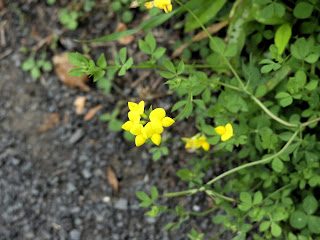Birds-foot Trefoil
Here's another wild legume I saw a couple months ago, a Common Birds-foot Trefoil. There are some similarities to the Purple Crownvetch I talked about yesterday:
- They're both considered invasive in North America, and are native to Eurasia/Africa.
- Their flowers have a similar shape to them.
- They're both legumes that are sometimes used as a food source for ruminants like cows, goats, and sheep.
- Both have root systems that are conducive to erosion control.
Note that although I suspect this is Common Birds-foot Trefoil, iNaturalist didn't give me an ID for this picture. I suspect that's because there are some other Birds-foot Trefoils that could be found around here. The leaves look wrong for this to be Narrow-leaf Birds-foot Trefoil and Horseshoe Vetch, but the difference between this and Greater Birds-foot Trefoil seems a bit more subtle (being taller and being a grayish-green in color).
Lepidopterists say they rarely see butterflies on this wildflower, though there are reports of some of our bumblebees using it as a nectar/pollen source. This is one of the prime problems with invasive plants; our insects and other animals either can't eat them, or doesn't recognize them as food.
The birds-foot trefoils get their name from their seed pods, believed by some to look a little like the feet of birds.
 |
| June 11, 2021 at Washington Valley Park Photo 136371864, (c) jpviolette, some rights reserved (CC BY-NC) |



Comments
Post a Comment